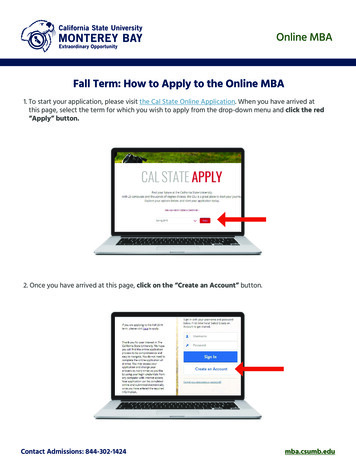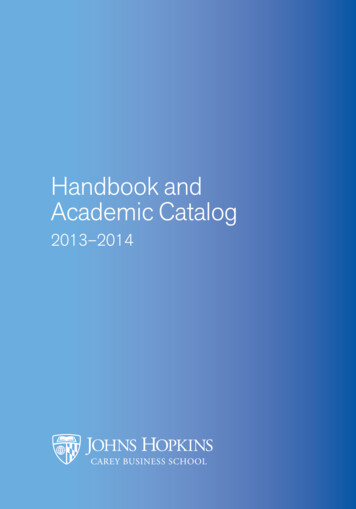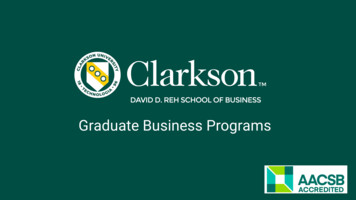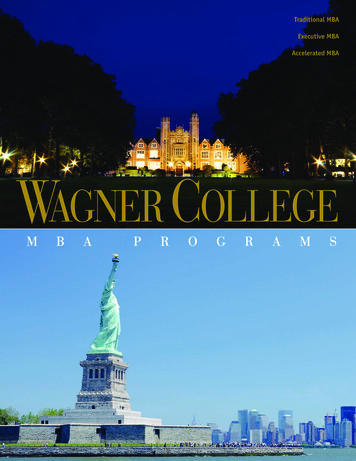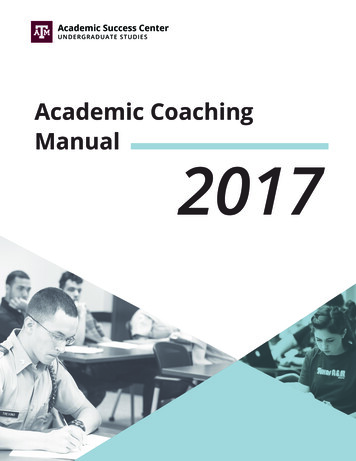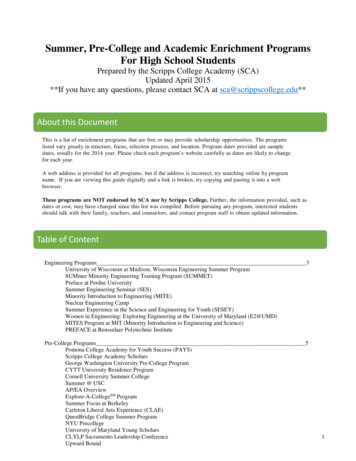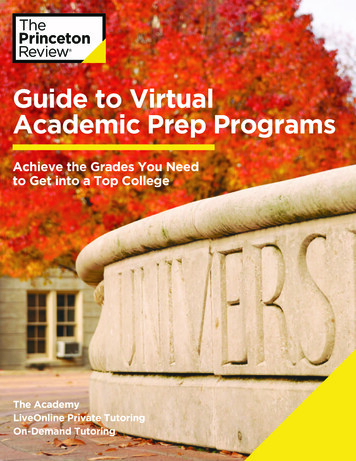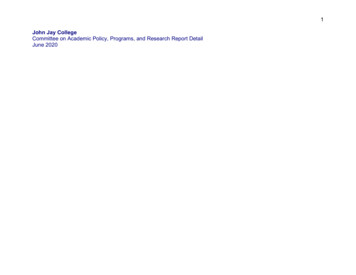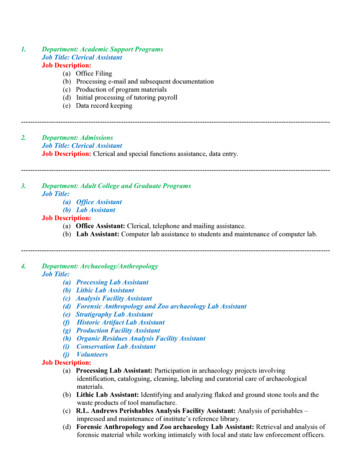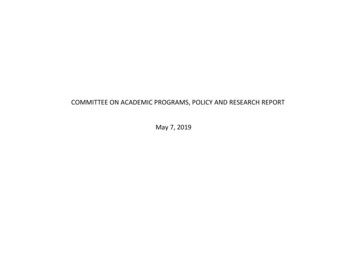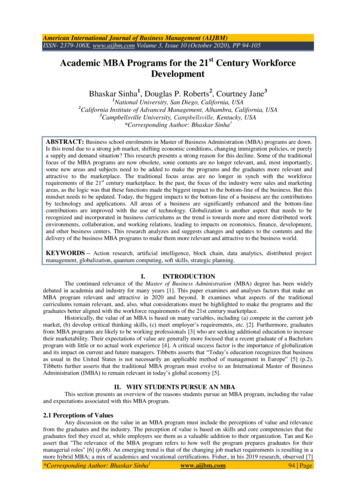
Transcription
American International Journal of Business Management (AIJBM)ISSN- 2379-106X, www.aijbm.com Volume 3, Issue 10 (October 2020), PP 94-105Academic MBA Programs for the 21st Century WorkforceDevelopmentBhaskar Sinha1, Douglas P. Roberts2, Courtney Jane312National University, San Diego, California, USACalifornia Institute of Advanced Management, Alhambra, California, USA3Campbellsville University, Campbellsville, Kentucky, USA*Corresponding Author: Bhaskar Sinha1ABSTRACT: Business school enrolments in Master of Business Administration (MBA) programs are down.Is this trend due to a strong job market, shifting economic conditions, changing immigration policies, or purelya supply and demand situation? This research presents a strong reason for this decline. Some of the traditionalfocus of the MBA programs are now obsolete, some contents are no longer relevant, and, most importantly,some new areas and subjects need to be added to make the programs and the graduates more relevant andattractive to the marketplace. The traditional focus areas are no longer in synch with the workforcerequirements of the 21st century marketplace. In the past, the focus of the industry were sales and marketingareas, as the logic was that these functions made the biggest impact to the bottom-line of the business. But thismindset needs to be updated. Today, the biggest impacts to the bottom-line of a business are the contributionsby technology and applications. All areas of a business are significantly enhanced and the bottom-linecontributions are improved with the use of technology. Globalization is another aspect that needs to berecognized and incorporated in business curriculums as the trend is towards more and more distributed workenvironments, collaboration, and working relations, leading to impacts on economics, finance, development,and other business centers. This research analyzes and suggests changes and updates to the contents and thedelivery of the business MBA programs to make them more relevant and attractive to the business world.KEYWORDS – Action research, artificial intelligence, block chain, data analytics, distributed projectmanagement, globalization, quantum computing, soft skills, strategic planning.I.INTRODUCTIONThe continued relevance of the Master of Business Administration (MBA) degree has been widelydebated in academia and industry for many years [1]. This paper examines and analyses factors that make anMBA program relevant and attractive in 2020 and beyond. It examines what aspects of the traditionalcurriculums remain relevant, and, also, what considerations must be highlighted to make the programs and thegraduates better aligned with the workforce requirements of the 21st century marketplace.Historically, the value of an MBA is based on many variables, including (a) compete in the current jobmarket, (b) develop critical thinking skills, (c) meet employer’s requirements, etc. [2]. Furthermore, graduatesfrom MBA programs are likely to be working professionals [3] who are seeking additional education to increasetheir marketability. Their expectations of value are generally more focused that a recent graduate of a Bachelorsprogram with little or no actual work experience [4]. A critical success factor is the importance of globalizationand its impact on current and future managers. Tibbetts asserts that “Today’s education recognizes that businessas usual in the United States is not necessarily an applicable method of management in Europe” [5] (p.2).Tibbetts further asserts that the traditional MBA program must evolve to an International Master of BusinessAdministration (IMBA) to remain relevant in today’s global economy [5].II. WHY STUDENTS PURSUE AN MBAThis section presents an overview of the reasons students pursue an MBA program, including the valueand expectations associated with this MBA program.2.1 Perceptions of ValuesAny discussion on the value in an MBA program must include the perceptions of value and relevancefrom the graduates and the industry. The perception of value is based on skills and core competencies that thegraduates feel they excel at, while employers see them as a valuable addition to their organization. Tan and Koassert that "The relevance of the MBA program refers to how well the program prepares graduates for theirmanagerial roles" [6] (p.68). An emerging trend is that of the changing job market requirements is resulting in amore hybrid MBA; a mix of academics and vocational certifications. Fisher, in his 2019 research, observed [7]*Corresponding Author: Bhaskar Sinha1www.aijbm.com94 Page
Academic Business Administration Programs for the 21st Century Workforcethat the Corporate Recruiters Survey Report indicated that specialized degrees and certificates are becomingmore sought after in the job market, than an MBA [8]. Given that business schools are tasked with preparinggraduates for the rigors of 21st century business, this disengagement is troubling.From the graduate’s perspective, the value or relevance of an MBA program is generally one thatprepares them with the skills and managerial capabilities to be competitive in today’s turbulent markets. To berelevant today, and into the future, the MBA curricula must prepare the graduate for their managerial role [6].Kolina, in 2006, concurred stating “The role of the teacher is changing from being the source of information tobeing an adviser and coach in the learning process” [9] (p.35). The primary challenge, from the graduate’sperspective, is ascertaining what course content is in fact relevant. In recent years, there has been a tendency forranking programs, by the institutions, as an indicator of perceived quality [10].The employer’s perception of value appears to be significantly different than the graduates [11]. Adisconnect exists in the perception of critical skills the graduates’ need as compared to the employer’srequirements. Muff, in 2012, reflects this same observation [12]. Commenting on a study involving sixty-sevencompanies across eight different industries, Muff further asserts that “business leaders across all industriespointed out that teamwork, soft skills, leadership, honesty, communications skills, flexibility, creativity,motivation, being a team-player and managerial skills are key factors enabling an individual to succeed inbusiness today” [12] (p.654). A study, conducted in 2018, revealed similar findings. The 2018 Financial TimesMBA Skills Gap Survey examined sector-specific results and graduate’s opinions. According to Nilsson in 2018“Some employers are questioning the value of MBAs. Some leading employers are increasingly sceptical aboutthe MBA qualification as a means of delivering candidates with the skills they need — soft or hard” [13] (p.10).Nilsson, quoting the assistant dean of MIT’s Sloan School of Management, asserts that the ability to build,sustain and expand a network, may be a skill employers’ highly value, but "unless [MBA graduates] havetechnical skill requirements, they are not even getting through the door" [13] (p.10). There is considerablesupport in the literature [2,6,13] that reflects that the MBA programs need to be a combination of academic andvocational skills to add value to the program. Tan and Ko suggest that “the MBA curricula is always a mix ofteaching managerial practice (i.e., similar to a vocational program imparting specific techniques) and thereasoning for the practice (i.e., similar to an academic program imparting the research and reasoning skills)" [6](p.65).In their 2017 research findings, Ahmad and Pesch, looking at the issue from a different perspective,suggest “Periodic surveys of employers and business students make important contributions in aligningemployer needs in new-hires with student skill sets and expectations.” [14] (p.1). Richards-Wilson andGalloway concur adding that business schools will benefit from surveying their graduates to ascertain what theirexperiences have been in the employment market [15]. By analysing the data, the schools are more likely toidentify emerging niche markets. An important source of relevant information is the annual survey of NationalAssociation of Colleges and Employers (NACE), piloted at St. Cloud State University in 2016, conducted at thestate or region level [16]. Many are joint ventures of business schools and industry employers to identify themost important skill sets for graduates.2.2 Alignment of ExpectationsThere is a pronounced misalignment of expectations, in terms of essential skills, between thegraduate’s understanding and the employer’s needs [13-14]. In a 2017 Financial Times survey of manyorganizations, participants were asked what skills employers were interested in. Nilsson in 2018 stated that "Ourdata shows that employers want to hire graduates with loosely defined qualities known as “soft skills”, such asthe abilities to work within a team and with a wide variety of people - rated most important by 64% and 54% ofrespondents respectively” [13] (p.1). This would suggest that employers are migrating from recruiting the highlyspecialized employee, one with specific skill sets, to that of a better-rounded candidate with emphasis on peopleover technical skills. Examining traditional MBA curriculums, Bell in 2017 asserts “Educators must producegraduates who are able to adapt to their jobs and effectively use their critical thinking skills to make strategicdecisions that further an organization” [2] (p.21).The literature reflects a changing view of the worth of the MBA. One reoccurring theme is that thevalue of MBA graduates who have real world work experience are perceived by employers as more attractive[7-13]. A common criticism of some schools is that they accept students with no real-world experience [7]. Thisdefeats the common goal of the MBA which is to augment experience with formal education, unless the teachershave industry experience and augment their teaching with real world examples and scenarios. By leveraging realworld experience from their peers and professors alike, students are able to get a more rounded businesseducation grounded in practice. Tan and Ko, in 2019, assert that “the MBA curricula is always a mix of teachingmanagerial practice (i.e., similar to a vocational program imparting specific techniques), and the reasoning forthe practice (i.e., similar to an academic program imparting the research and reasoning skills)" [6] (p.65). Bell in2017 suggested that “Business education must meet employer expectations in order to retain its value” [2]*Corresponding Author: Bhaskar Sinha1www.aijbm.com95 Page
Academic Business Administration Programs for the 21st Century Workforce(p.21). As Ahmad and Pesch observed in 2017, there is a combination of skill sets that are more or less universalto employers [14]. As organizations become more information driven, additional skill sets, focused aroundtechnology, are also in demand [2]. In their examination of survey data from the National Association ofColleges and Employers (NACE), Ahmad and Pesch found that the employers identified; (1) honesty/integrity,(2) strong work ethic, (3) interpersonal skills, (4) professionalism, (5) develop creative solutions, (6) thinkanalytically, as key skills [14]. Additional skills, such as interpersonal, flexibility, and teamwork were alsoidentified. In contrast, DuPre and Williams examined perceptions of employer expectations, stated “The 2010Job Outlook, an annual NACE publication, listed these desired characteristics as, in order of importance,communication skills, analytical skills, teamwork skills, technical skills (as related to major), and a strong workethic” [11] (p.8). Some segments of industry have a very interesting approach to the topic. Moules and Nilsson,in discussing their research of 48 companies world-wide, “spanning 12 business sectors in e-commerce,industry, and finance” [10] (p.3) suggest:Employers in some sectors, such as oil and gas, civil engineering, transport and energy, seelittle need for senior staff to hold an MBA degree. Part of the reason, they say, is that theydo not believe that business schools teach the right skills (p.1)In 2019, R. Fisher, conducting a similar study of employers, concluded that:Because the MBA degree no longer holds the prestige that it once did, other master’s levelqualifications may better serve some people in their search for an executive level job.Simply put, MBAs are no longer rare and as such are no longer a guarantee foremployment. Employers no longer view an MBA as a differentiating factor, unless the MBAwas obtained at one of the world’s best business schools [7] (p.11)One methodology for ensuring alignment of expectations is to constantly seek feedback from graduatesand employers. Demonstrating to employers that MBA graduates add value to their organization provides astrong case for differentiating them from non-MBA graduates. Important sources of relevant information areannual surveys (American Association of Colleges and Universities, National Association of Colleges andEmployers (NACE), Saint Cloud State University, etc.), conducted at the state or region levels. Many are jointventures between business schools and employers to identify the most important skill sets for MBA graduates.III. DECLINING ENROLLMENT IN TRADITIONAL MBA PROGRAMSIs the MBA degree obsolete? A number of statistics have indicated that demand for the MBA degree issoftening [17]. Is this trend of declining MBA applications a sign that the MBA is losing relevance in today’sfast-moving economy [18]? This research suggests ‘NO’ to both these questions. Is an MBA degree still a goodinvestment [17]? This research suggests ‘YES’.Graduating MBA students of the year 2019 have had no trouble landing good jobs. In most cases,starting pay has hit record levels and placement rates for schools are at or near records as well. Yet, for thesecond consecutive year, even the highest ranked business schools in the U.S. are beginning to report significantdeclines in MBA applications and the worse is yet to come, with many MBA programs experiencing doubledigit declines [19]. Last year, the top ten business schools combined saw a drop of about 3,400 MBA applicants,a 5.9% falloff to 53,907 candidates versus 57,311 a year earlier [19]. The University of Michigan Ross SchoolOf Business experienced the worst drop, an 8.5% decline from 3,485 to 3,188 apps. Harvard fell 4.5%, UCBerkeley Haas 7.5%, Wharton 6.7%, Stanford 4.6%, and Booth 8.2% [20].The Kaplan Test Prep Survey (2018), and prevailing literature, reflects a changing business andpolitical environment [21]. The results suggest that although there is a good job market, students arediscouraged from applying to MBA programs due to: International potential students are uneasy about the current political situation in the U.S.A. The job market in the U.S.A. is relatively strong The cost and duration to complete an MBA degree. Anxieties about the value of an MBA degree. The shortage of accelerated one-year MBA programs in the United States. The perception that fewer jobs require an MBA in the 21st century than in years past.The challenges posed by the current situation in recruiting international students will continue. But thechallenges the business schools are facing are getting to be quite critical as far as recruitment is concerned,especially for international students.IV. MBA PROGRAMS FOR THE 21ST CENTURYGiven the decline in enrolments to MBA programs, this research attempts to highlight the key factorsthat should be focussed on for the success of the 21st Century MBA.*Corresponding Author: Bhaskar Sinha1www.aijbm.com96 Page
Academic Business Administration Programs for the 21st Century Workforce4.1 Program Curriculum Design and ContentOne of the critical steps in defining the MBA program, and ultimately the success of the degree, isprogram design. This design must evolve, with the state of the art, as new skills and core competencies emerge[2]. Keeping up with technical and other innovations and improvements, and changing trends in the businessworld, are critical to maintaining the relevance of the program. Forsyth and Anastasia, in 2016, observed thatsimulations are an effective way of tracking outcomes and meeting the spirit of the Higher EducationOpportunity Act of 2008 [22-23]. Expanding on the concepts suggested by Tan and Ko [6], Bell has proposedthat programs should be a mixture of academic rigor and industry certifications [2]. The program that isconstantly evaluating the job market and expectations, keeping up with innovation, and adapting to changingconditions, will continue to remain relevant. The focus should be on facilitating a model that provides the verybest in academic rigor along with practitioner skills. Programs utilizing experiential learning, realistic real-lifecase studies, and team consulting projects, are most likely to develop the highly sought-after soft skills, problemsolving ability, and analytical abilities in students [6]. Programs with specific in-demand concentrations, such asanalytics, big data, and artificial intelligence, have the potential to fill the niche market demand while producinga graduate that has the fundament skills and core competencies. The literature is lacking in terms of addressingcontinuing education with respect to adding future classes (continuing education) that would maintain therelevance of the graduate MBA program. By following this suggested methodology, the MBA graduates, ineffect, will be “reinventing themselves” on a continuous basis to meet the ever changing workplace demands.4.2 Program Cost and SpecializationThe MBA program needs to be redesigned and offered at a significantly lower cost. In this space,specialized MS degrees are offered typically as Master of Finance, Master of Accounting, Master ofManagement, Master of Entrepreneurship, Master of Information Systems, etc. Although some schools offeradditional options such as Master of Medical Management, but these are not very common. These MS degreestake only one year and have correspondingly lower tuition than the traditional two-year MBA, making themmuch more attractive. They appeal to younger students with little or no work experience, and who want to focusin depth on a narrow field such as finance or accounting. Accordingly, the MS degrees lack the breadth andscope of the general management orientation of the traditional two-year MBA. These trends indicate thatalthough the MBA degree is not obsolete, it needs to be updated with relevant content and focus, based on themarket and workforce requirements of the 21st century.4.3 Management Training EmphasisTraditionally, the main purpose of an MBA degree is to teach students how to manage a company, andto train qualified executives who have a global vision for business. The overall objective of the MBA is toprepare students to assume positions of leadership and responsibility in administrative positions in a globallycompetitive marketplace. Customarily, the curriculum is designed to enhance the skills, knowledge, andanalytical ability of our MBA graduates. To prepare students for the challenges of the marketplace, the MBAcurriculum offers in-depth knowledge of the business principles, accounting, finance, marketing, management,management information systems (MIS), and operations management. Important applications in ethics,leadership, and communication are also covered. The objectives are that the graduates are able to (1) understandbusiness practices, (2) work with the administration to optimize business processes, (3) apply current practicesto international businesses, and (4) to formulate strategies for the success of the business. The end goal of theMBA program is to educate and prepare a diverse group of men and women with the knowledge, analyticalability, and management perspectives and skills needed to provide leadership to organizations competing in aworld increasingly characterized b
3Campbellsville University, Campbellsville, Kentucky, USA *Corresponding Author: Bhaskar Sinha1 ABSTRACT: Business school enrolments in Master of Business Administration (MBA) programs are down. Is this trend due to a strong job market, shifting econ

